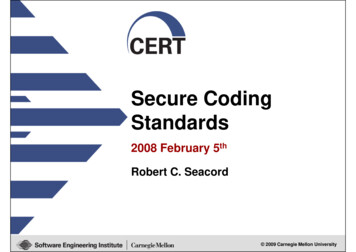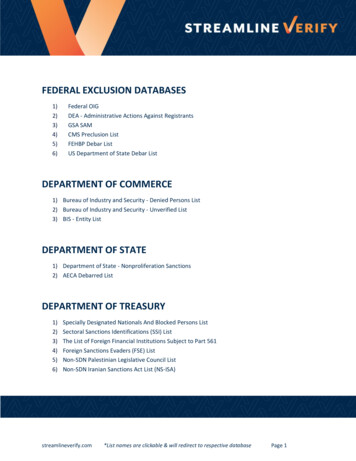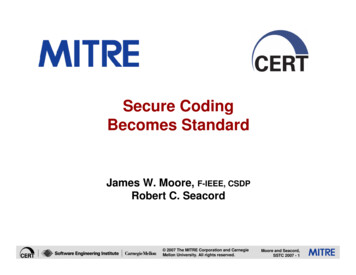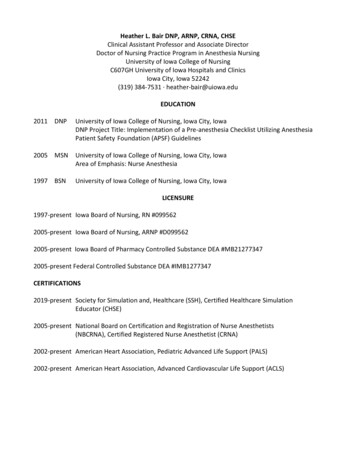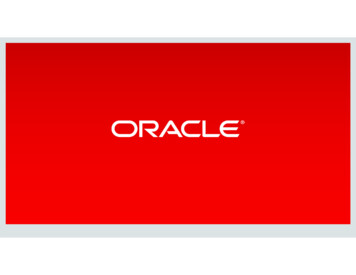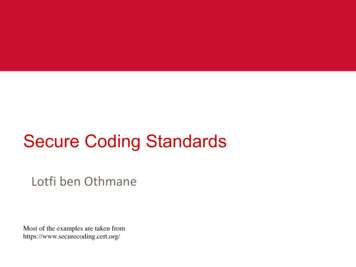
Transcription
Secure Coding StandardsLotfi ben OthmaneMost of the examples are taken fromhttps://www.securecoding.cert.org/
What a SDLC is Up To? Is SDLC sufficient to producing secure software?Does SDLC? Ensure development of secure software? lead to developing secure software? support developing secure software?2
Vulnerabilities 022003200420052006200720082009201020112012Code ExecutionDoSOverflowMemory CorruptionSql InjectionXSSDirectory TraversalBypass somethingGain PrivilegesCSRF20132014Source: www.cvedetails.com3
Types of Vulnerabilities Design-based vulnerabilities E.g., Broken access control, data leakage due to logic flaw Language-based vulnerabilities E.g., Buffer overflow, XSS4
Misplaced Trust Different components may havedifferent trust levelsData coming from untrustedcomponent should be validated beforeused by a trusted component.Example of certificate authority of TheNetherlands where the certificatesigning system was hosted with apublicly accessible Web application(accessed using non-changed defaultpassword)Untrusted componentPartner WebapplicationWeb serviceCommand interpreterTrusted component5
Secure Programming Overview How SQL injection attack works?How XSS attack works?How buffer overflow attack works? How to prevent them? What is the relation between programing languages andvulnerabilities? 6
Injection Attacks Attack examples Command injection SQL injection XSSSolutionü Data validation – data are valid inputü Sanitization – ensure conformance of input to a setrequirements, by e.g., removing some charactersü Canonicalization – reduce the data to minimum, e.g., filepath7
Secure Programming Overview Secure programming (aka defensive coding) refers to codingrules and practices that help avoiding known codevulnerabilities.There are several secure coding standards, such as CERT,OWASP, NIST.Organizations develop their own APIs to avoid knownvulnerabilities. E.g., data validation.We give in this lecture some advices on how to avoid a set ofwell known attack vectors.8
Secure Programming Overview9
Injection Attacks-2 SELECT * FROM db user WHERE username 'validuser' OR '1' '1' ANDpassword PASSWORD Non-CompliantString sqlString "SELECT * FROM db user WHERE username '" username "' AND password '" pwd "'";Statement stmt connection.createStatement();ResultSet rs stmt.executeQuery(sqlString); CompliantString sqlString "select * from db user where username ? and password ?";PreparedStatement stmt ing(1, username);stmt.setString(2, pwd);ResultSet rs stmt.executeQuery(); 10
Memory Mis-Management# include stdlib .h # include stdio .h # include string .h int bof( char *str) {char buffer [24];strcpy ( buffer , str );return 1;}What is the vulnerability here?How to avoid it?int main (int argc , char ** argv ) {char str [517];FILE * badfile ;badfile fopen (" badfile ", "r");fread (str , sizeof ( char ), 517 , badfile );bof (str );printf (" Returned properly \n");return 1;}11
Memory Mis-Management-2# include stdlib .h # include stdio .h # include string .h Example of solutionsint bof( char *str) {char buffer [24];buffer[23] ‘\0’;strncpy ( buffer , str, 23);return 1;}int main (int argc , char ** argv ) {char str [517];FILE * badfile ;badfile fopen (" badfile ", "r");fread (str , sizeof ( char ), 517 , badfile );bof (str );printf (" Returned properly \n");return 1;}12
Memory Mis-Management-3Other pages/viewpage.action?pageId 437 MEM30-C. Do not access freed memory MEM31-C. Free dynamically allocated memory when no longer needed MEM33-C. Allocate and copy structures containing a flexible arraymember dynamically MEM34-C. Only free memory allocated dynamically MEM35-C. Allocate sufficient memory for an object MEM36-C. Do not modify the alignment of objects by calling realloc()13
Data LeakageHow can the data beleaked?public class Credentials implementsSerializable {private string password;public string password) {this. password password;}}public class usepassword extends Credentials {public static void main(String[] args) {FileOutputStream fout null;try {Credentials p new Credentials(“SecretPassword”);fout new Stream oout newObjectOutputStream(fout);oout.writeObject(p);} catch (Throwable t) {// Forward to handler} finally {if (fout ! null) {try {fout.close();} catch (IOException x) { .}14
Data Leakage-2public class Credentials implementsSerializable {private String password;public Credentials (String password) {PerformSecurityManageCheck();this. password password;}}Does this solve the problem?public class usepassword extends credentials {public static void main(String[] args) {FileOutputStream fout null;try {Credentials p newCredentials(“SecretPassword”);fout putStream oout newObjectOutputStream(fout);oout.writeObject(p);} catch (Throwable t) {// Forward to handler} finally { .}What about making the password field transient?15
Denial of Service Causes include Upload large files Force infinite loops Initiate many connections Force deadlocks Insert keys with the same hash code Operate on mismanaged sharing of files Force division by zero16
Denial of Servicestatic final int BUFFER 512;// .What is the problem?public final void unzip(String filename) throws java.io.IOException{FileInputStream fis new FileInputStream(filename);ZipInputStream zis new ZipInputStream(new BufferedInputStream(fis));ZipEntry entry;try {while ((entry zis.getNextEntry()) ! null) {System.out.println("Extracting: " entry);int count;byte data[] new byte[BUFFER];// Write the files to the diskFileOutputStream fos new ream dest new BufferedOutputStream(fos, BUFFER);while ((count zis.read(data, 0, BUFFER)) ! -1) {dest.write(data, 0, count);} .}}17
Denial of Servicestatic final int BUFFER 512;static final int TOOBIG 0x6400000; // 100MB// .public final void unzip(String filename) throws java.io.IOException{ try {while ((entry zis.getNextEntry()) ! null) { .byte data[] new byte[BUFFER];// Write the files to the disk, but only if the file is not insanely bigif (entry.getSize() TOOBIG ) {throw new IllegalStateException("File to be unzipped is huge.");}if (entry.getSize() -1) {throw new IllegalStateException("File to be unzipped might be huge.");}FileOutputStream fos new ream dest new BufferedOutputStream(fos, BUFFER);while ((count zis.read(data, 0, BUFFER)) ! -1) {dest.write(data, 0, count);} .} finally {zis.close();}}Does this solve the problem?https://www.securecoding.cert.org/18
Exception HandlingHow difficult it is to read sensitive files?class ExceptionExample {public static void main(String[] args) throws FileNotFoundException {// Linux stores a user's home directory path in// the environment variable HOME, Windows in %APPDATA%FileInputStream fis new FileInputStream(System.getenv("APPDATA") args[0]);}}19
Exception Handling-2class ExceptionExample {public static void main(String[] args) {Does this solve the problem?File file null;try {file new File(System.getenv("APPDATA") args[0]).getCanonicalFile();} catch (IOException x) {System.out.println("Invalid file");return;}try {FileInputStream fis new FileInputStream(file);} catch (FileNotFoundException x) {System.out.println("Invalid file");return;}}}20
Exception Handling-3public class Operation {public static void doOperation(String some file) {// . Code to check or set character encoding .try {BufferedReader reader new BufferedReader(new FileReader(some file));try {// Do operations} finally {reader.close();// . Other cleanup code .}} catch (IOException x) {// Forward to handler}}}21
Exception Handling-3public static void doOperation(String some file) {// . Code to check or set character encoding .try ( // try-with-resourcesBufferedReader reader new BufferedReader(new FileReader(some file))) {// Do operations} catch (IOException ex) {System.err.println("thrown exception: " ex.toString());Throwable[] suppressed ex.getSuppressed();for (int i 0; i suppressed.length; i ) {System.err.println("suppressed exception: " suppressed[i].toString());}// Forward to handler}}Java SE 7 introduced afeature called try-withresources22
Cryptographic Weaknesses Causes include: Use of weak cryptographic algorithmsØ E.g., DES encryption shall not be used anymoreUse of weak parametersØE.g., RSA encryption key of 1024 is weak Wrong use of APIs Wrong order of API calls Bypass illegitimately errors and warnings23
Cryptographic Weaknesses-2 Weakpublic static byte[] encrypt(String plainText, String encryptionKey) throws Exception {Cipher cipher Cipher.getInstance(“DES/CBC/NoPadding", "SunJCE");SecretKeySpec key new ES");cipher.init(Cipher.ENCRYPT MODE, key,new IvParameterSpec(IV.getBytes("UTF8")));return cipher.doFinal(plainText.getBytes("UTF-8"));} Goodpublic static byte[] encrypt(String plainText, String encryptionKey) throws Exception {Cipher cipher Cipher.getInstance(“AES/CBC/PKCS5Padding", "SunJCE");SecretKeySpec key new ");cipher.init(Cipher.ENCRYPT MODE, key,new IvParameterSpec(IV.getBytes("UTF8")));return cipher.doFinal(plainText.getBytes("UTF-8"));}24
Unauthenticated Method Calls Causes include (illegitimate) Call of methods of frameworks/Librariesused by other co-hosted software (illegitimate) Injection of method calls for libraries thataccept dynamically generated code25
Mis-configuration Causes include Sensitive information, such as database passwords arekept in Web application configuration Providing debugging information Etc.26
Conclusions Secure programming (aka defensive coding) refers to codingrules and practices that help avoiding known codevulnerabilities. The rules and practices are, in general, technologydependent Developers shall apply these rules and practicesOrganizations develop APIs that help avoiding vulnerabilitiessuch as malicious inputApplying the recommended rules and principles does notimply safety from code-vulnerabilities Last year an attacker succeeded in bypassing a rule forexecuting code embedded in JPEG images on WordPress27
Thank youAny Question?28
Secure programming (aka defensive coding) refers to coding rules and practices that help avoidingknowncode vulnerabilities. There are several secure coding standards, such as CERT, OWASP, NIST. Organizations develop their own APIs to avoidknown vulnerabilities. E.g., data validation.
